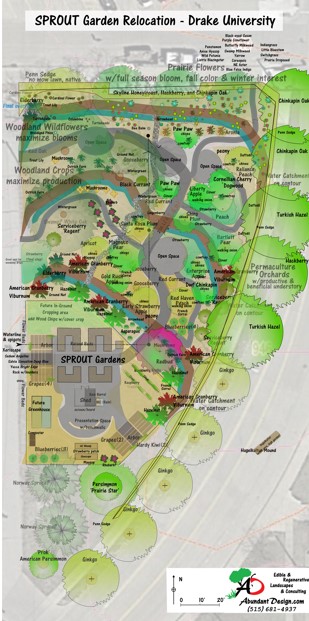Food Forest
The Drake Food Forest is a half-acre permaculture expansion to Sprout. The Food Forest ecosystem will serve as an outdoor learning lab focused on sustainable urban agriculture and provide another community access point to healthy and fresh foods.
Designed by: Jeff Reiland, Owner of Abundant Design, LLC.

Food Forests are a relatively new concept in Iowa. Food forests serve as a park for reflection and relaxation, a food source, and a place for education. Food forests are based on permaculture design and offer numerous environmental and health benefits for the communities they are in. The food forest follows a planting model designed to mimic the ecosystems and patterns found in nature and contains seven layers:
-The canopy containing large fruit and nut trees
-The understory contains smaller fruit trees like peaches, semidwarf apples, and redbud
-Shrub layer that includes gooseberry, currant, and raspberries
-Herbaceous plants like chives, yarrow (beneficial insect food source), and milkweed
-Root crops such as potatoes, horseradish, and ground nut
-Ground cover like strawberries, wintergreen, and nitrogen-fixing clover
-Vertical climbers such as grapes, passion flowers, and kiwi (yes, you can grow kiwi in Iowa!)
The new Food Forest ecosystem at Drake will contain more than 60 food-producing trees and shrubs, 100s of edible perennials and ground cover plants, pollinator-attracting flowers and natives, three contour swales creating runoff rain gardens, four community gathering spaces, and a therapeutic walking trail.
For more information about Food Forests and Permaculture check out the resources below:
Permaculture Overview: https://abundantdesigniowa.blogspot.com/2015/05/happy-international-permaculture-day.html
Agroforestry: https://agroforestry.libsyn.com/agroforestry-in-urban-landscapes
Atlanta Food Forest
Seattle Food Forest
St Petersburg FL Food Forest
Planting Tree Guilds:
Basically design the various layers of a forest in your space, using plant analogues that benefit the grower and the system, as it gets established and reaches maturity.
www.gardeningknowhow.com/special/organic/how-to-plant-tree-guild.htm
https://www.tenthacrefarm.com/how-to-build-a-fruit-tree-guild/
Food Forest Orchard Companions
- Comfrey is a deep tap-rooted plant that will access nutrients deeper and sooner than the slower-growing trees. The big leaves can be cut down and left as fertilizing mulch, maybe once during the first season, and 2-4 times the following seasons. Bumble bees also like their purple bell-like flowers Mine are sterile so they won’t produce seed spreading aggressively, but like horseradish or dandelion, they will sprout readily from any piece of root left behind. So, they will be hard to remove if your plans change.
- Clover is a nice ground cover that keeps the soil cool, suppresses many weed seeds from germinating, and reduces moisture loss. They also fix nitrogen with symbiotic bacteria, free fertilizer. Red clover is larger and produces more nitrogen and possible forage. White clover doesn’t grow too tall and is a favorite of honeybees.
- The onion/chive family with its distinct aroma helps protect young trees from rabbits.
- Daffodils are also a protective plant as they are toxic to rabbits. Early spring plants also tie up nutrients in their leaves which could be lost through rain and runoff before other plants start using them.
- Oregano, thyme, sage, and many other herbs have antimicrobial properties that can help prevent disease in your trees, as well as in yourselves. They are also good for pollinators and adult predatory insects.
- Yarrow and other small cluster-flowering plants provide nectar for parasitoid wasps and other predatory insects, like lacewings, that feed on pest insects. Ladybugs and their larvae are another great predator of aphids and other pests.
